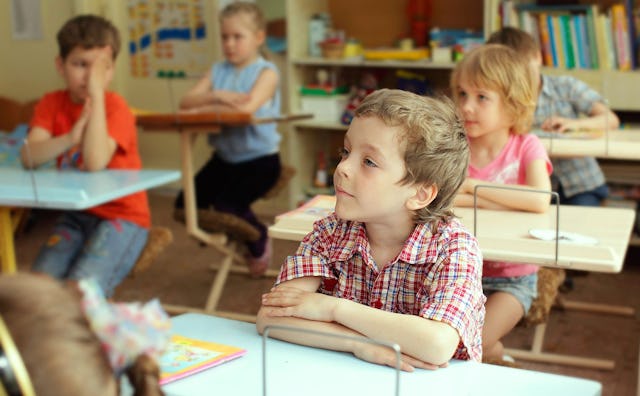Here's What Really Matters About Your Kid's Elementary School

A year and a half ago, my husband and I started talking elementary school for our son. He has a few medical needs, so we actually just opened up Google Maps and tried to find a school that was close to his hospital and also close to our home. We lucked out: There was a great school almost exactly between the two.
It turns out this school is one of those schools: It’s a magnet school you usually have to be admitted to through a lottery and doing so is pretty hard. You could live across the street and it wouldn’t help you get in—”neighborhood school” isn’t a phrase you hear in the hallways. The teachers are all excellent, the principal is dedicated, and it even has wizards (the school mascot) and unicorns painted in the hallways. I mean, it’s a dream.
With all that in mind, we assumed our son wouldn’t get in. I dutifully went to the information session and tossed his name into the figurative hat—along with more than 100 kindergarten hopefuls. We started making other plans, and got to know our neighborhood school quite well.
Here’s the thing about our neighborhood school: It’s pretty awesome, but not in the ways that you might think should count the most. Like a lot of new-to-school parents, we looked at all the things they say you should look at: test scores (right at or just below the state average), student-teacher ratio (not the best, but not the worst) and the student body in general. After volunteering in the building weekly since the start of the year, I get good vibes from the place. The teachers and staff I’ve worked with have all been dedicated and upbeat, and the kids seem to be pretty happy.
Just when we were all A-OK and registered with the neighborhood school, we found out our son made it into the dream school. We immediately accepted and switched over—we didn’t even give the neighborhood school a second glance. I mean, this school … that’s what everyone wants, right? A smaller school with an awesome focus, well-funded activities, and a small student body that knows each other well into middle school? I didn’t even realize those kinds of schools existed anymore.
Our son has so far had an amazing year. He’s challenged and happy, he’s thriving in his class, and he’s finally picking up on social cues from kids his own age. His school has an energy that I have yet to see anywhere else, and after also volunteering there weekly, I can tell you that the teachers are phenomenal. The staff is supportive and also the sweetest, and our principal knew our names from the first day of school.
But what I’ve realized is that so much of what’s great about my son’s school—the energy, the focus, the dedication, and the general enthusiasm for learning—isn’t because it’s a school that a lot of people in the area want to get their kids into. It isn’t because the test scores are stellar and the student-teacher ratio is awesome. To me, the clearest reason why my son’s school is incredible is that so many of the parents are involved. Parents—both those who have jobs outside of the home and those who don’t—are seriously all over that school. There are weekly activities led by parents, and they volunteer in the elementary classrooms and help shelve books in the library. Parents get to know the teachers their kids will have years down the road, and as a result, a bond is forged from the very early years. Teachers know the parents, parents know the teachers, and a community that has the kids at the forefront is formed. It’s incredible.
Does this exist at my neighborhood school? I can almost guarantee you it does. Does it exist at every neighborhood school? Maybe not. What I’ve learned is that what matters the most when it comes to the school your kid goes to, what will truly help push your child to succeed and love learning, is a commitment to creating an environment in which children can explore and gravitate to what most interests them. What matters is helping to build a learning experience that encourages children to create and be curious, and one that supports teachers, staff and the administration. It’s easy to get turned off by murals you don’t like or frightened by test scores that are low, but I think it’s more important to still get to know the schools right around you.
We’re getting ready to move later this summer, and our son is zoned into a gigantic school. The test scores are pretty disheartening, and the student body is almost triple the size of the school he’s in now. I’m still a little concerned about the latter. How do kids not get lost in mega-schools? And by lost, I mean emotionally and mentally. But, we’re planning to forge ahead and give the school a try. It’s close enough to our new home to walk, the principal has already been so tremendously helpful even though we’re not there yet, and the student population is incredibly ethnically and racially diverse (a big plus to us!). We’ll see what we—and most importantly, he—make of it. We know that if it’s all a horrible experience we have options, and we’re going into this new school with a touch of caution and a whole bunch of optimism.
You hear it a lot, and I’m going to say it again: Our communities are only as strong as our commitment to them. One reason I volunteer in my neighborhood school, and the reason I’ll continue to volunteer at my son’s new school later this year, is that I want to see as many kids as possible succeed—whether they’re at my kid’s school or not.
This article was originally published on